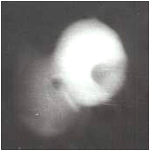For the efficient recovery of intracellular proteins, enzymes, and nucleic acids
Conventional Methods of Microbial Cell Disruption
Microbial intracellular proteins with catalytic or biological activity are of great importance to the biotechnology industry. The release of these proteins and enzymes from their microbial hosts is a key unit operation in the manufacture of recombinant proteins such as biosynthetic insulin.
For the large-scale disruption of microorganisms, mechanical disintegrators such a high-pressure homogenization and wet milling in high-speed agitator bead mills are commonly employed, techniques originally designed for the milk and paint industries.
Problems and Challenges
These techniques utilize high shear forces and generate heat, both factors which are potentially damaging to the proteins being recovered.
Furthermore, these methods frequently generate small cell wall fragments that are difficult to separate from the process stream and thus lead to the fouling of adsorbents and clogging of chromatographic columns in the downstream protein manufacturing process. The disintegrated cell wall also increases the bio-burden and endotoxin levels. While cell disintegration is not a requirement for the recovery of intracellular proteins, it is a necessary consequence of conventional microbial cell disruption techniques.
SuperFluids™ CFD
 Aphios Corporation’s critical fluid microbial cell disruption (CFD) process avoids some of the problems and challenges of conventional microbial cell disruption processes.
Aphios Corporation’s critical fluid microbial cell disruption (CFD) process avoids some of the problems and challenges of conventional microbial cell disruption processes.
CFD is based on the physical phenomenon that large explosive decompressive forces can be readily effected upon the depressurization of supercritical, critical or near-critical fluids with or without polar cosolvents [SuperFluids™], and is further enhanced by their unique solvation and transport properties [US Patent].
In the CFD process, microbial cells are contacted with SuperFluids™, which penetrate the cells and swell them. Upon decompression, the cells either rupture at their weakest points as a result of decompressive forces – like the embolic disruption of a scuba diver’s ear from rising too rapidly – or become more permeable, releasing their intracellular contents as a result of phospholipid solvation and delipidation. CFD results in a single-point rupture at the cell’s weakest point without the disintegration of the cell wall.
Benefits and Advantages
- More effective than industrial-scale processes at equivalent pressures. While high-pressure homogenizers are ineffective against Bacillus subtilis (a tough Gram-positive bacterium), at pressures less than 8,000 psig, the CFD process readily disrupts this species at pressures less than 5,000 psig.
- Negligible product activity degradation due to mechanical and thermal effects because there are very little shear and no heat generation. The CFD process, in fact, provides significant Joule-Thompson cooling to the microbial cell slurry and recovered proteins.
- Generally applicable to various classes of microorganisms since the ability to adjust pressure, temperature and residence time imparts various degrees of flexibility to the CFD process.
- Highly selective in that SuperFluids™ conditions can be adjusted to recover periplasmic proteins and enzymes versus cytoplasmic constituents such as proteins, enzymes, and nucleic acids.
- Readily scalable up or down, amenable to batch or continuous-flow operations and applicable to microbial slurries or solids (dry cells).
Contracting/Partnering Opportunity/Technology Transfer
We will contract/partner with biotechnology companies to incorporate CFD into your manufacturing process for the efficient recovery of intracellular proteins, enzymes, and nucleic acids.
We will also provide research-scale units to biotechnology companies, universities and research institutions to complement and improve your product and process development activities.